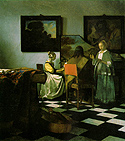SATURDAY ESSAY
The 'Monuments Men' changed history
Late Toledo museum director had part in saving art treasures
By ROBERT M. EDSEL
PRESIDENT John F. Kennedy once said, "A nation reveals itself not only by the men it produces but also by the men it honors, the men it remembers."
On this Veterans' Day, Nov. 11, we have the opportunity - the duty - to recognize an extraordinary group of men and women who, during and following World War II, often at great peril and risk, served with frontline military units to locate, safeguard, and repatriate millions of priceless works of art and irreplaceable cultural archives, including masterpieces by Da Vinci, Michelangelo, Rembrandt, and Vermeer, that had been stolen by Hitler and the Nazis.
One such individual was a man still revered in Toledo, the late director of the Toledo Museum of Art, Otto Wittmann. In fact, one of the museum's greatest treasures, Rubens' "The Crowning of St. Catherine," was reclaimed from the Nazis and repatriated before becoming part of Toledo's collection.
Known as "Monuments Men" by their fellow GIs, this small unit of men and women comprised the War Department's Monuments, Fine Art, and Archives (MFAA) section. Among their ranks were volunteer museum directors and curators, and artists, as well as art academics, historians, and scholars from more than 15 nations.
It was the first time in history an army fought a war while concurrently attempting to minimize damage to art and cultural treasures.
Inadequately equipped, staffed, and supported, the Monuments Men were largely left to their own creativity and ingenuity. There was no rule book for what they would confront.
They created special aerial maps for bombing pilots to identify key cultural monuments to avoid, effected temporary repairs to churches and other monuments, and in what became the greatest treasure hunt in history, located millions of stolen artworks, whole libraries, and other irreplaceable archival and religious items.
They were often in harm's way. In fact, two Monuments Men - Capt. Walter Huchthausen of the United States and Maj. Ronald E. Balfour of Great Britain - both lost their lives while protecting works of art during battle.
In the decades before and after the war, many of the Monuments Men played critical roles in building some of the greatest cultural institutions in this country and elsewhere.
Few of these individual accomplishments have been acknowledged, and even fewer in the context of what the men and women of the MFAA did as a group to vault the United States onto the cultural world stage.
In Toledo, Mr. Wittmann became the associate director of the Toledo Museum of Art in 1946 and its director in 1959. He helped build the museum into a world-class institution, tripling the size of the collection, and in the process, became internationally recognized for community and educational programs.
Mr. Wittmann also went on to serve as a board member of the Los Angeles County Museum of Art, the J. Paul Getty Museum, a founding member of the National Council on the Arts, as well as an advisor to the National Endowment for the Arts (NEA) and the National Endowment for the Humanities (NEH).
Other Monuments Men and women have served in similar roles at our country's most acclaimed institutions, including the Metropolitan Museum of Art, Museum of Modern Art, and New York City Ballet, all in New York City, the Nelson-Atkins Museum of Art in Kansas City, the Cleveland Museum of Art, and the National Gallery of Art in Washington, D.C.
Only a few of the Monuments Men received individual commendations for their unprecedented and heroic work. Major Wittmann received several commendations from foreign governments, including the Legion of Honor of France, Order of the Orange-Nassau of the Netherlands, and Commander, Order of Merit of Italy.
Sadly, he, like so many others who served the MFAA, was never recognized nor commended by the United States for his service to mankind. As a group, the Monuments Men and women were lost in the fog of history.
There are only a scant few of the 400 or so Monuments Men still living. It would be unconscionable for the commendation and recognition they so justly deserve to be given posthumously. The United States and the world have much to celebrate in the unprecedented contributions of these heroic men and women, for we are the beneficiaries of their contributions to humanity every time we visit a museum anywhere in the world.
The time has come for all to know about their heroic role in saving many of the greatest, most beloved works of art in the world.
Their actions proved art is worth a life, and that the preservation of culture and our civilization matter greatly.
Robert M. Edsel is a businessman in Dallas, Texas, and author of a book called "Rescuing Da Vinci," describing Hitler's obsession with art and the Monument Men's determination to recover art stolen from the Nazis and return it to its rightful owners.
So, over to you FBI Agent Robert Wittman, you are the natural heir and successor to Otto Wittmann, your mission is to educate the masses to appreciate art and prevent masterpieces being stolen from the public eye.
A fitting tribute to Otto Wittman by FBI Agent Robert Wittman will be the recovery of the stolen Vermeer "The Concert" this being the modern day "Holy Grail"
So, dust yourself down Bob, take a deep breath, and go recover the Vermeer, you have all the ingredients, "Now bake the cake"

No comments:
Post a Comment